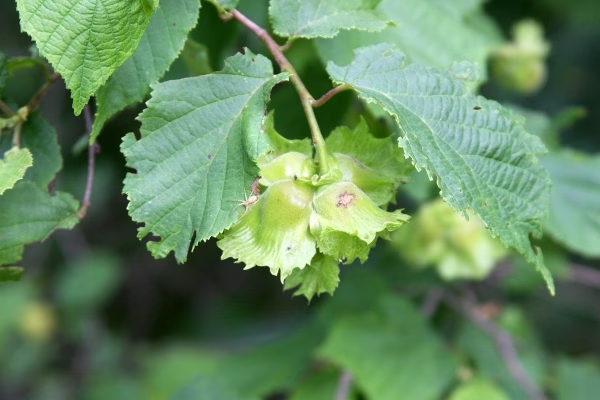
American Hazelnut
Botanical Name
:
Corylus americana
Plant Type
:
Deciduous shrub
Seasons
:
Plant in early spring or early fall; blooms from late winter to early spring
Sun Level
:
Full sun to partial shade; does well in 6 hours of direct sunlight a day
Ideal Soil Temperature for Planting
:
60–70°F (15–21°C)
Soil Type
:
Well-drained soil, tolerates a wide range of soil types including clay
Hardiness Zones
:
3–9 (USDA)
Germination
:
Seeds generally take 6 to 12 months to germinate after cold stratification
P.H. Level
:
5.5–7.0 (acidic to neutral)
Water/Irrigation
:
Keep soil consistently moist but not waterlogged. Mulch to retain moisture
Fertilization
:
Use a balanced fertilizer (e.g., 10-10-10) in early spring
Habit
:
Multi-stemmed, spreading shrub or small tree with arching branches
Propagation
:
By seed, softwood cuttings in early summer, or hardwood cuttings in late fall or early winter
Final Plant Height
:
8–16 ft
Spread
:
10–15 ft
Flowers
:
The male flowers are typically yellowish and are borne in long, pendulous catkins that can appear in early spring. Female flowers are smaller and appear as green bell-shaped structures with bright red stigmas and styles. They are clustered at the ends of short branches
Attracts
:
Bees, butterflies, and birds
Uses
:
Ornamental, wildlife habitat, erosion control, hedges, and borders
Companions
:
Viburnums, wild blueberry, serviceberry, red maple, comfrey, clover, garlic, nasturtium, and yarrow
Pruning
:
Prune in late winter or early spring to remove dead or damaged wood and to maintain shape. Spreading in the form of suckers from the roots should be thinned out to prevent or reduce thickets
Toxicity
:
Non-toxic to humans and pets
Pests
:
Spider mites, scale insects, fungus gnats, fruit flies, mealybugs, filbertworms, filbert aphids, and hazelnut aphids
Diseases
:
Eastern filbert blight, powdery mildew, and canker
Additional Info
:
American Hazelnut nuts are a favorite food for many wildlife species, including squirrels, deer, and birds. The nuts are also edible for humans and can be used in various culinary dishes
Botanical Name
:
Corylus americana
Plant Type
:
Deciduous shrub
Seasons
:
Plant in early spring or early fall; blooms from late winter to early spring
Sun Level
:
Full sun to partial shade; does well in 6 hours of direct sunlight a day
Ideal Soil Temperature for Planting
:
60–70°F (15–21°C)
Soil Type
:
Well-drained soil, tolerates a wide range of soil types including clay
Hardiness Zones
:
3–9 (USDA)
Germination
:
Seeds generally take 6 to 12 months to germinate after cold stratification
P.H. Level
:
5.5–7.0 (acidic to neutral)
Water/Irrigation
:
Keep soil consistently moist but not waterlogged. Mulch to retain moisture
Fertilization
:
Use a balanced fertilizer (e.g., 10-10-10) in early spring
Habit
:
Multi-stemmed, spreading shrub or small tree with arching branches
Propagation
:
By seed, softwood cuttings in early summer, or hardwood cuttings in late fall or early winter
Final Plant Height
:
8–16 ft
Spread
:
10–15 ft
Flowers
:
The male flowers are typically yellowish and are borne in long, pendulous catkins that can appear in early spring. Female flowers are smaller and appear as green bell-shaped structures with bright red stigmas and styles. They are clustered at the ends of short branches
Attracts
:
Bees, butterflies, and birds
Uses
:
Ornamental, wildlife habitat, erosion control, hedges, and borders
Companions
:
Viburnums, wild blueberry, serviceberry, red maple, comfrey, clover, garlic, nasturtium, and yarrow
Pruning
:
Prune in late winter or early spring to remove dead or damaged wood and to maintain shape. Spreading in the form of suckers from the roots should be thinned out to prevent or reduce thickets
Toxicity
:
Non-toxic to humans and pets
Pests
:
Spider mites, scale insects, fungus gnats, fruit flies, mealybugs, filbertworms, filbert aphids, and hazelnut aphids
Diseases
:
Eastern filbert blight, powdery mildew, and canker
Additional Info
:
American Hazelnut nuts are a favorite food for many wildlife species, including squirrels, deer, and birds. The nuts are also edible for humans and can be used in various culinary dishes
Written by Nondiah Khalayi – https://www.linkedin.com/in/nondiah-khalayi/

